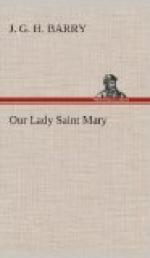Thus early in our Lord’s life is the element of tragedy introduced. The Incarnation of God stirs the diabolic powers, the rulers of “this darkness” to excited activity. The companion picture of the Nativity, of the Holy Child lying in Mary’s arms, of the wondering shepherds, of the Magi from a far country,—the shadow of all this idyllic beauty is the massacre of the Innocents, the wailing of Rachel for her children. It is, as it were, the opening of a new stage in the world-old conflict where the powers of evil appear to have the advantage and can show the bodies of murdered infants as the trophies of their victory.
But are we to think of the death of a child as a disaster? Has any actual victory redounded to the Prince of Power of the Air? One understands of course the grief and sense of loss that attends the death of any child, the breaking of the dreams which had gathered about its future. What the father and the mother dreamed over the cradle and planned for the future does not come to pass—all that is true. But in a consideration of the broader interests involved, does not the death of a baby have a meaning far deeper than a disappointment of hopes and dreams? It is true, is it not? that the coming of the child brought enrichment into the life of its parents? There was a new love born for this one child which is not the common property of all the children of the family, but is the peculiar possession of this child and its parents. Life—the life of the parents—is better and nobler by virtue of this love. They understand this, because when they stand by the side of the child’s coffin they never feel that it had been better that this child had not come into existence. And more than that: as they commit this fragile body to the grave they know that there is no real sense in which they can say that they have lost this child. Rather, the child is a perpetual treasure, for the moment contemplated through tears, but presently to be thought of with unclouded joy. It is so wonderful a thing to think of this pure soul caught back to God; to think of it growing to spiritual maturity in God’s very presence; to think of it following the Lamb withersoever He goeth. Yes: to think of it also as our child still, with our love in its heart, knowing that it has a




